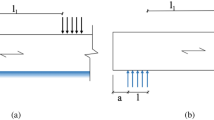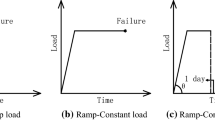Abstract
Linear vibration welding of timber structural elements provides new opportunities to potentially achieve structural joints. This paper investigates to which extent welded joints can be considered for load-bearing structural joints. On the basis of a series of experimental and numerical investigations on a series of welded single-lap joints, failure modes were identified, and the associated failure criterion was quantified. A probabilistic method subsequently allowed accurately predicting the capacity of the tested wood welded joints exclusively based on objective input data, including an estimate of the scattering due to the material’s inherent variability.









Similar content being viewed by others
References
Da Silva LFM, Das Neves PJC, Adams RD, Spelt JK (2009a) Analytical models of adhesively bonded joints–Part I: literature survey. Int J Adhesion and Adhesives 29(3):319–330
Da Silva LFM, Das Neves PJC, Adams RD, Wang A, Spelt JK (2009b) Analytical models of adhesively bonded joints–Part II: comparative study. Int J Adhesion and Adhesives 29(3):331–341
Ganne-Chédeville C, Properzi M, Leban JM, Pizzi A, Pichelin F (2008a) Wood welding: chemical and physical changes according to the welding time. J Adhesion Sci Technol 22(7):761–773
Ganne-Chédeville C, Duchanois G, Pizzi A, Leban JM, Pichelin F (2008b) Predicting the thermal behaviour of wood during linear welding using the finite element method. J Adhesion Sci Technol 22(12):1209–1221
Gfeller B, Zanetti M, Properzi M, Pizzi A, Pichelin F, Lehmann M, Delmotte L (2004) J. Adhesion Sci Technol 17:1573–1589
Gliniorz KU, Mohr S, Natterer J, Navi P (2001) Wood welding. In: Proceedings of the 1st international conference of the European society for wood mechanics, Lausanne, Switzerland, pp 571–574
Goland M, Reissner E (1944) The stresses in cemented joints. J Appl Mech 29 (Trans. ASME) 11:A17–A27
Green DW, Winandy JE, Kretschmann DE (1999) Mechanical properties of wood. In: Wood handbook—wood as an engineering material. Forest Products Laboratory, Madison
Hart-Smith LJ (1974) Analysis and design of advanced composite bonded joints. Accession Number: 74N20564, Document ID: 19740012451, Report Number: NASA-CR-2218
Kasal B, Leichti RJ (2005) State of the art in multiaxial phenomenological failure criteria for wood members. Prog Struct Eng Mater 7(1):3–13
Lamon J (2001) A micromechanics-based approach to the mechanical behavior of brittle-matrix composites. Compos Sci Technol 61(15):2259–2272
Leban J-M, Pizzi A, Wieland S, Zanetti M, Properzi, Pichelin F (2004) X-ray microdensitometry analysis of vibration-welded wood. J Adhesion Sci Technol 18:673–685
Leban JM, Pizzi A, Properzi M, Pichelin F, Gelhaye P, Rose C (2005) Wood welding: a challenging alternative to conventional wood gluing. Scand J For Res 20:534–538
Montgomery DC, Runger GC (2003) Applied statistics and probability for engineers. Wiley, New York
Norris CB (1962) Strength of orthotropic materials subjected to combined stresses. Report No. 1816. Forest Products Laboratory, Madison
Oudjene M, Khelifa M, Segovia C, Pizzi A (2010) Application of numerical modelling to Dowel-Welded wood joints. J Adhesion Sci Technol 24(2):359–370
Properzi M, Leban JM, Pizzi A, Wieland S, Pichelin F, Lehmann M (2005) Influence of grain direction in vibrational wood welding. Holzforschung 59(1):23–27
Stamm B, Natterer J, Navi P (2005) Joining wood by friction welding. Holz Roh- Werkst 63:313–320
Sutthoff B, Franz U, Hentschel H, Schaaf A (1996) Verfahren zum reibschweissartigen Fügen und Verbinden von Holz. Patentschrift DE 196 20 273 C2, Deutsches Patent- und Markenamt
Tannert T, Vallée T, Hehl S (2010a) Probabilistic design of adhesively bonded timber joints, part I: experimental and numerical investigations. Submitted to Wood Sci Technol
Tannert T, Vallée T, Hehl S (2010b) Probabilistic design of adhesively bonded timber joints, part II: strength prediction. Submitted to Wood Sci Technol
Tsai MY, Oplinger DW, Morton J (1998) Improved theoretical solutions for adhesive lap joints. Int J Solids Struct 35(12):1163–1185
Vallée T, Correia JR, Keller T (2006a) Probabilistic strength prediction for double lap joints composed of pultruded GFRP profiles–Part I: experimental and numerical investigations. Compos Sci Technol 66(13):1915–1930
Vallée T, Correia JR, Keller T (2006b) Probabilistic strength prediction for double lap joints composed of pultruded GFRP profiles–Part II: strength prediction. Compos Sci Technol 66(13):1915–1930
Volkersen O (1938) Nietkraftverteilung in zugbeanspruchten konstanten Laschenquerschnitten. Luftfahrtforschung 15:41–47
Weibull W (1939) A statistical theory of strength of materials. In: Proceedings of the Royal Swedish Institute. Research No. 151, Stockholm, Sweden
Xavier JC, Garrido NM, Oliveira M, Morais JL, Camanho PP, Pierron F (2004) A comparison between the Iosipescu and off-axis shear test methods for the characterization of pinus pinaster ait. Compos Part A: Appl Sci Manuf 35(7–8):827–840
Zou GP, Shahin K, Taheri F (2004) An analytical solution for the analysis of symmetric composite adhesively bonded joints. Compos Struct 65(3–4):499–510
Author information
Authors and Affiliations
Corresponding author
Rights and permissions
About this article
Cite this article
Vallée, T., Tannert, T. & Ganne-Chedville, C. Capacity prediction of welded timber joints. Wood Sci Technol 46, 333–347 (2012). https://doi.org/10.1007/s00226-011-0404-4
Received:
Published:
Issue Date:
DOI: https://doi.org/10.1007/s00226-011-0404-4




